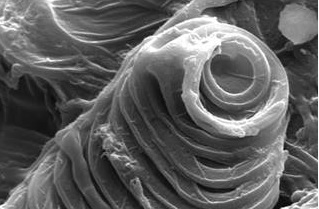Microescultura da testa da semente madura de Ruellia elegans Poir. (Acan-thaceae)
DOI:
https://doi.org/10.20873/jbb.uft.cemaf.v8n4.indriunasPalavras-chave:
helicoidal thickenings, Ruelliaea, trichomesResumo
Ruellia L. é o segundo maior gênero da família Acanthaceae e, como a maioria dos representantes dessa, possui frutos capsulares loculicidas explosivos. O estudo da morfologia e principalmente da microescultura das sementes em Acanthaceae tem se mostrado importante para compreensão das relações taxonômicas e ecológicas. R. elegans Poir. é uma espécie endêmica da Mata Atlântica emprega como ornamental. O presente trabalho tem por objetivo descrever a morfologia e microescultura da testa de sementes maduras de R. elegans Poir. fornecendo subsídios para a taxonomia do grupo, bem como para estudos ecológicos para o entendimento dos padrões de dispersão das sementes. As sementes foram analisadas sob microscopia eletrônica de varredura, sendo apresentada a descrição do formato e indumento. A descrição e análise da microescultura da testa da semente madura da espécie corroboram com seu atual posicionamento taxionômico devido à presença de tricomas mucilaginosos por toda a superfície e esta característica indica a síndrome de dispersão ectozoocórica.
Referências
Al-Hakimi AS, Maideen H., Latiff A. Pollen and Seed Mor-phology of Rhinacanthus Nees and Hypoestes Sol. ex R. Br. (Acanthaceae) of Yemen. Sains Malaysiana, v. 44, n. 1, p. 7-15, 2015.
Aoyama EM, Indriunas A, Vitória EL, Monteiro MM. Carac-terização morfológica de frutos e sementes de Justicia scheidweileri. Natureza on line, v. 13, p.3, p. 134-140, 2015.
Azevedo IHF, Braz DM. Seed morphology of Ruellia L. (Ac-anthaceae) from the Southeastern Brazilian Atlantic rain for-est: Taxonomic, phylogenetic, and ecological. Flora, v. 240, p. 48-57, 2018. https://doi.org/10.1016/j.flora.2017.12.011
Balkwill K, Campbell-Young G. Taxonomic studies in Acan-thaceae: testa microsculpturing in southern African species of Thunbergia. Botanical Journal of Linnean Society, v. 131, p. 301-325, 1999.
Balkwill K, Schoonraad E. Taxonomic studies in Acanthaceae: testa microsculpturing in southern African species of Peristrophe. South African Journal of Botany, v. 52, p. 513-520, 1999.
Ezcurra C. Systematics of Ruellia (Acanthaceae) in southern South America. Annals of the Missouri Botanical Garden, v. 80, p. 787-845, 1993.
Greuter W, Rodríguez RR. Notes on some endemic Cuban species of Ruelliinae (Acanthaceae), on their seeds, pollen morphology and hygroscopic features. Willdenowia, v. 40, P. 285-304, 2010. https://doi.org/10.3372/wi.40.40210
Indriunas A, Aoyama EM, Kameyama C. Microescultura da testa da semente madura de Herpetacanthus chalarostachyus Indriunas & Kameyama (Acanthaceae). Natureza on line, v. 12, n. 1, p. 48-50, 2014.
Kiel CA, MCDADE LA. The Mirandea Clade (Acanthaceae, Justicieae, Tetramerium Lineage): phylogenetic signal from molecular data and micromorphology Makes Sense of taxo-nomic confusion caused by remarkable diversity of floral form. Systematic Botany, v. 39, p. 950–964, 2014. https://doi.org/10.1600/036364414X681446
Lorenzi H, Souza HM. Plantas ornamentais no Brasil: arbusti-vas, herbáceas e trepadeiras. São Paulo: Nova Odessa. 2008.
Payne WW. A glossary of plant hair terminology. Brittonia, v. 30, n. 2, p. 239–255, 1978.
Peichoto MC. Estudios morfo-anatómicos em espécies de Justicia (Acanthaceae) del nordeste argentino. Darwiniana, v. 36, p. 13-28, 1998
Ruengsawang K, Chantaranothai P, Simpson DA. Contribu-tions to the seed morphology and taxonomy of Justicia (Ac-anthaceae) from Thailand. Journal of Systematics and Evolu-tion, v. 50, p. 153–162, 2012. https://doi.org/10.1111/j.1759-6831.2012.00178.x
Schaffnit E. Beiträge zur Anatomie der Acanthaceen-Samen. Beihefte zum Botanischen Centralblatt, Abt. 1, v. 19, p. 453 – 521, 1906.
Schnepf E, Deichgräber G. Structure and formation of fibrillar mucilages in seed epidermis cells: II. Ruellia (Acanthaceae). Protoplasma, v. 114, p. 222-234, 1983.
Tripp EA. Evolutionary relationships within the species-rich genus Ruellia (Acanthaceae). Systematic Botany, v. 32, p. 628-649, 2007. https://doi.org/10.1600/036364407782250625
Tripp EA, Daniel FD, Fatimah S, Mcdade LA. Phylogenetic relationships within Ruellieae (Acanthaceae) and a revised classification. International Journal of Plant Sciences, v. 174, p. 97-137, 2013. https://doi.org/10.1086/668248
Tripp EA, Fatimah S. Comparative anatomy, morphology, and molecular phylogenetics of the african genus Satanocrater (Acanthaceae). American Journal of Botany, v. 99, n. 6, p. 967–982, 2012. https://doi.org/10.3732/ajb.1100354
Tripp EA, Mcdade LA. Time-calibrated phylogenies of hum-mingbirds and hummingbird-pollinated plants reject a hy-pothesis of diffuse co-evolution. Aliso, v. 31, n. 2, p. 89–103, 2013.

Downloads
Publicado
Como Citar
Edição
Seção
Licença
Copyright (c) 2024 - Journal of Biotechnology and Biodiversity

Este obra está licenciado com uma Licença Creative Commons Atribuição 4.0 Internacional.
Autores que publicam nesta revista concordam com os seguintes termos:
Autores mantêm os direitos autorais e concedem à revista o direito de primeira publicação, com o trabalho simultaneamente licenciado sob a Licença Creative Commons Attribution (CC BY 4.0 no link http://creativecommons.org/licenses/by/4.0/) que permite o compartilhamento do trabalho com reconhecimento da autoria e publicação inicial nesta revista.
Autores têm autorização para assumir contratos adicionais separadamente, para distribuição não exclusiva da versão do trabalho publicada nesta revista (ex.: publicar em repositório institucional ou como capítulo de livro), com reconhecimento de autoria e publicação inicial nesta revista.
Autores têm permissão e são estimulados a publicar e distribuir seu trabalho online (ex.: em repositórios institucionais ou na sua página pessoal) a qualquer momento antes ou durante o processo editorial, já que isso pode gerar alterações produtivas, bem como aumentar o impacto e a citação do trabalho publicado (disponibilizado em O Efeito do Acesso Livre no link http://opcit.eprints.org/oacitation-biblio.html).


